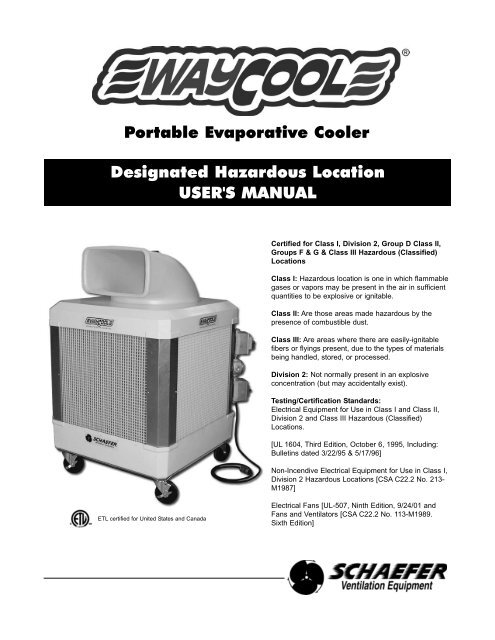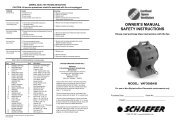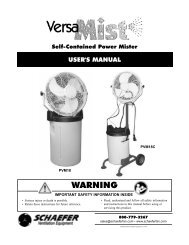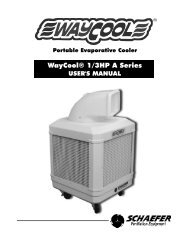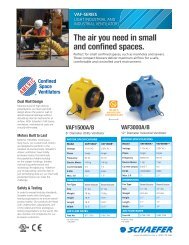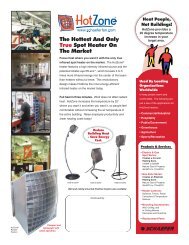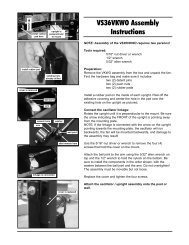WayCool Designated Hazardous Location Evaporative Cooler Manual
WayCool Designated Hazardous Location Evaporative Cooler Manual
WayCool Designated Hazardous Location Evaporative Cooler Manual
Create successful ePaper yourself
Turn your PDF publications into a flip-book with our unique Google optimized e-Paper software.
Portable <strong>Evaporative</strong> <strong>Cooler</strong><strong>Designated</strong> <strong>Hazardous</strong> <strong>Location</strong>USER'S MANUALCertified for Class I, Division 2, Group D Class II,Groups F & G & Class III <strong>Hazardous</strong> (Classified)<strong>Location</strong>sClass I: <strong>Hazardous</strong> location is one in which flammablegases or vapors may be present in the air in sufficientquantities to be explosive or ignitable.Class II: Are those areas made hazardous by thepresence of combustible dust.Class III: Are areas where there are easily-ignitablefibers or flyings present, due to the types of materialsbeing handled, stored, or processed.Division 2: Not normally present in an explosiveconcentration (but may accidentally exist).Testing/Certification Standards:Electrical Equipment for Use in Class I and Class II,Division 2 and Class III <strong>Hazardous</strong> (Classified)<strong>Location</strong>s.[UL 1604, Third Edition, October 6, 1995, Including:Bulletins dated 3/22/95 & 5/17/96]Non-Incendive Electrical Equipment for Use in Class I,Division 2 <strong>Hazardous</strong> <strong>Location</strong>s [CSA C22.2 No. 213-M1987]ETL certified for United States and CanadaElectrical Fans [UL-507, Ninth Edition, 9/24/01 andFans and Ventilators [CSA C22.2 No. 113-M1989.Sixth Edition]
Table of ContentsINTRODUCTION ............................................................................................................................3Why use evaporative coolers in your workplace ............................................................................3How evaporative cooling works ......................................................................................................3ABOUT THIS MANUAL ..................................................................................................................4SAFETY INFORMATION ................................................................................................................4SAFETY RECOMMENDATIONS....................................................................................................5WC-1HP-DHL SPECIFICATIONS ..................................................................................................6WC-1HP-DHL DESCRIPTION........................................................................................................7WATER SUPPLY SYSTEM ........................................................................................................8-9COOLING PAD ASSEMBLY ........................................................................................................10BLOWER AND DUCTWORK........................................................................................................11CONTROL ....................................................................................................................................12OPERATION AND MAINTENANCE ............................................................................................12Unit placement and other considerations ....................................................................................12Unpacking and initial setup ..........................................................................................................13Regular cleaning ..........................................................................................................................14Normal startup ..............................................................................................................................14Normal shutdown..........................................................................................................................14TROUBLESHOOTING..................................................................................................................15Cooling pads not wetting ..............................................................................................................15Foaming........................................................................................................................................15Line clogs or obstructions ............................................................................................................15Odor control ..................................................................................................................................15Scale buildup ................................................................................................................................15Splattering in front ........................................................................................................................15Leaking from the bottom ..............................................................................................................15OPTIONS AND ACCESSORIES ..................................................................................................16Water conditioner and cleaner......................................................................................................16PRODUCT SUPPORT..................................................................................................................17WARRANTY ................................................................................................................................172
IntroductionWHY USE EVAPORATIVE COOLERS IN YOUR WORKPLACE• The <strong>WayCool</strong> ® evaporative cooler requires little space, has a low initial cost, is inexpensive and simple tooperate and requires minimal scheduled maintenance.• Due to the design and construction of the cooling pads, cooling efficiency is normally maintained nearoptimum throughout the life of the pads (approximately two seasons).• In many cases, evaporative coolers are a better solution than mechanical refrigeration systems because theyare more economical to operate and maintain, and do not use environmentally sensitive and costlyrefrigerants.HOW EVAPORATIVE COOLING WORKSPipe drippingwater onto padsWetted cellulosepadsWarm dry airgreater than90 deg. F.Figure WC-1HP-DHL.02 - <strong>Evaporative</strong> Cooling PrincipleCool moist airless than80 deg. F.<strong>Evaporative</strong> cooling is the same process your body uses to cool itself. When you perspire, and air moves acrossyour skin, a portion of the perspiration (water) evaporates. Evaporation requires heat to change liquid water towater vapor and this heat is taken from your skin, producing the cooling effect.In an evaporative cooler, the cellulose cooling pads take the place of your skin, water instead of perspirationwets them and a fan moves the air. The air blows across the cooling pads and evaporates moisture. Heat isdrawn from the pads and the air, dropping the air temperature and producing the cooling effect. The cooled airis then forced through a building or space and displaces the warm air out of building openings, cooling thesurroundings. In addition, air velocity increases the cooling effect as it moves over the skin of people in theairflow path.<strong>WayCool</strong> ® evaporative coolers are portable and use the latest technology to provide large volumes of cool air,efficiently and inexpensively, for cooling small to medium size areas. Simply add more units to accommodatelarger areas. With proper sizing and application, a <strong>WayCool</strong> ® portable evaporative cooler can lower the effectiveair temperature by up to 20 degrees F. Even in high humidity, the efficiency of the <strong>WayCool</strong> ® evaporative coolerprovides effective cooling.3
About This <strong>Manual</strong>The intent of this manual is to help you in two ways: to provide you with step-by-step instructions for quick andeasy assembly of your product, and to serve as a reference for simple maintenance and questions you mayhave regarding your product.Read ALL instructions carefully before starting your <strong>WayCool</strong> ® . Pay particular attention to all SAFETYinformation.Optional equipment contains necessary instructions for assembly and/or operation.The <strong>WayCool</strong> ® <strong>Evaporative</strong> <strong>Cooler</strong> is labeled with a serial number. The serial number is locatedinside the unit on the aluminum frame, behind the switch. Removal of the serial number label willvoid all warranties.All information, illustrations and specifications in this manual are based on the latest product informationavailable at the time of printing. Product specifications subject to change. We reserve the right to make changesat any time without notice.Safety InformationWarning and Danger Decals have been placed on the equipment to warn of potentially dangerous situations.Care should be taken to keep this information intact and easy to read at all times. Replace missing or damagedsafety decals immediately. The diagram below shows the proper location of the safety decals as shipped fromthe factory.Start Unit -Turn water pump on 5-10minutes before running blower to wetevaporative cooling pads.Shut Down -Turn pump off and run onlyblower until evaporative cooling pads are dry.This prolongs the life of the pads.WARRANTY- VOID IF YOU RUN THEPUMP WITHOUT WATER.CAUTION - ALWAYS TURN OFF ATSWITCH AND DISCONNECT POWERBEFORE REMOVING EVAPORATIVECOOLING PADS FOR CLEANING ORINTERNAL MAINTENANCE.CLEANING - Clean pads a minimum of onceevery two weeks. Remove pads from unitand clean with garden hose only. DO NOTuse chemicals or high pressure hose.ATTENTION!The unit is suitable foroutdoor locations, but cannot beused with an extension cord.WARNING!The motor in this unit isequipped with automaticthermal protection.The motor can start up or shutdown automatically. Ensurepower is removed beforeremoving protectivegrates and pads.3019762ETL LISTEDCONFORMS TOUL STD 307UL STD 1804CERTIFIED TOCSA C22.2 STDNO. 113CAN/CSA C22.2STD NO. 213WARNING!This unit can ONLY be use in the <strong>Hazardous</strong> <strong>Location</strong>s listed on thislabel. The unit is certified for Not-Normally <strong>Hazardous</strong> <strong>Location</strong>s:Class1, Division 2, Group DClass 2, Division 2, Groups F & GClass 3 <strong>Location</strong>sAs described by the "National Fire Protection Association"Codes NFPA 597 and NFPA 599Please review these codes to fully understand permitted applicationsand locations prior to use of this productFigure WC-1HP-DHL.03 - Decals4
Using the equipment for purposes other than specified in this manual may cause personal injury and/or damageto the equipment.Safety Alert SymbolThis is a safety alert symbol. When you see this symbol on your equipment, be alert to the potentialfor personal injury. This equipment is designed to be installed and operated as safely as possible;however, hazards do exist.Signal Words are used in conjunction with the safety alert symbol to identify the severity of the warning.CAUTION indicates an imminently hazardous situation, which, if not avoided, COULD cause damage to yourequipment or equipment failure.WARNING indicates a potentially hazardous situation, which, if not avoided, COULD result in death or seriousinjury.READ AND SAVE THESE INSTRUCTIONS!Safety Recommendations• This is an electric device with moving components. There is the possibility of fire, electric shock or injury topersons. Ensure all the safety recommendations are adhered to in order to minimize this risk.• Disconnect all power and unplug the unit before you inspect, clean or perform maintenance on thecomponents of the unit.• Never reach into the unit when it is running; you could become entrapped by the V-belt or injured by therotating fan blades.• The metal frame edges are sharp; don't run your hand along them. Be careful and wear gloves when youreach under the frame to inspect the PVC pipes and mesh socks.• A GFCI (Ground Fault Circuit Interrupter) is recommended for use with this product.• If pads and grates are removed for servicing, they must be replaced prior to operating the unit.• Do not service the electrical components unless you are certified to do so.• Unit cannot be used with a solid-state control device.• An extension cord cannot be used with this unit.• Unit can only be used in an environment it has been certified for.PLEASE NOTE• Minimum inlet pressure is 10 PSI; maximum inlet pressure is 100 PSI.• Never leave unit unattended while in operation.5
WC-1HP-DHL SpecificationsActual WC-1HP-DHL<strong>WayCool</strong> ® varies slightlyfrom unit shown here.Figure WC-1HP.04 - <strong>WayCool</strong> ® <strong>Evaporative</strong> <strong>Cooler</strong> Overview• Height and Width - 33" x 33" wide x 54" high (with casters and directional spout).• Shipping Weight - 265 pounds.• Blower - double-inlet centrifugal.• Motor - 1 HP, 115-208/230V, 60 Hz.• Pump - submersible, vane type, 280 GPH (gallons per hour).• Pump Filter - washable polyethylene filter.• Pump Discharge Filter - 480 micron stainless steel.• Reservoir Capacity - 24 gallons.• Optional Water Supply - standard 3/4" hose connection (garden hose size).• Housing - high impact ABS plastic with UV protection.• Evaporation Media - chemically treated cellulose paper.6
WC-1HP-DHL DescriptionThe <strong>WayCool</strong> ® evaporative cooler is a completely self-contained, portable unit capable of delivering 40 MPHvelocity of air with a temperature drop of up to 20 degrees F. The unit is composed of:• Level-controlled water supply system• Cooling pad assembly• Motor-driven blower and ductwork• Controls• Frame and housingThe reservoir is made of high impact ABS plastic and holds approximately 24 gallons at normal operating level(about 5" deep).A float-operated valve automatically maintains proper water level when the unit is connected to a water supply.The reservoir rests on, and is fixed to, an aluminum cradle. The reservoir, in turn, is secured to the aluminumframe. Four casters (two locking, two regular) are attached to the underside of the aluminum cradle.A pump draws water from the reservoir and discharges it through the vinyl hose to the PVC pipes located abovethe cooling pads. The PVC pipes distribute water onto the top of the cooling pads; saturating them. Excesswater drips back into the reservoir through the holes in the cooling pad support channels.The cellulose cooling pads sit in support channels and are held in place by plastic retaining grates. The gratesalso help prevent damage to the cooling pads. Two pad sections fit in each side of the unit (total eight sections)to totally enclose the unit.The blower is hung from the top of the frame and powered by a belt-driven 1HP electric motor. The blowerdraws room air through the cooling pads where it picks up moisture and cools by evaporation. The blower thendischarges the cooled air through the spout.It is important the cooled space has sufficient air openings so the warmer air can flow out and bereplaced by the cooled air. A closed-in space or high humidity will reduce the cooling effect. See UNITPLACEMENT AND OTHER CONSIDERATIONS in the "Operation and Maintenance" section of thismanual.A screen covers the discharge duct to prevent foreign objects from entering the blower. A threaded rod screwsthrough a threaded brace above the screen to hold the spout in position. A plastic knob secures the spout to therod. The spout is made of a tough, durable plastic and can be manually rotated 360 degrees to provide cool airin any direction without moving the unit.Water weighs about eight pounds per gallon, so when the unit is full it weighs over 375 pounds. Duringsetup and before startup, place the unit in the desired location and then fill the reservoir. Do not attemptto lift the unit once it is filled and be careful to avoid spills when moving it, even over smooth ground.Do not try to push it over rough or soft ground as you can overstress the wheels and frame and causestructural and component damage, which is not covered by the warranty.7
Water Supply SystemActual WC-1HP-DHLActual WC-1HP<strong>WayCool</strong><strong>WayCool</strong> ® ® varies slightlyvaries slightlyfrom unit shown here.from unit shown here.Figure WC-1HP-DHL.05 - Water Supply SystemThe reservoir can be supplied continuously with an ordinary garden hose by attaching the supplied hose adapter(see Figure WC-1HP-DHL.07) to the fill connection, or it can be filled manually.With a continuous water supply connected, the float valve in the reservoir (like the one in your toilet tank) risesand falls with the water level. A linkage attaches the float to the shutoff valve in the fill connection. As the waterlevel rises to normal operating level (about 5" deep), the float valve shuts off the water supply. When the waterlevel drops, the float valve reopens to maintain a normal operating level.After unplugging the unit, the reservoir can also be manually filled with a hose or bucket, if a hose connection isimpractical. Simply remove any of the plastic retaining grates and one of the cooling pad sections and place thehose, or pour the water, directly into the reservoir. When you fill the reservoir manually it can be filled to a higherlevel, but make sure someone monitors the filling operation to avoid overfilling and flooding.Water damage due to overfilling is not covered by the warranty.When you run the unit and fill it manually, check the water level frequently so it does not run dry.Operating the pump without water will damage it or reduce its service life. This is not covered by thewarranty. The cooling effect also stops if the pads dry.Pads and grates must be replaced before operating unit.8
Water Supply System cont'dA drain in the reservoir allows you to drain the unit for cleaning and maintenance. A drain cap on the undersideof the aluminum tray covers the drain during operation. Make sure the cap is in place before you fill thereservoir. The drain cap should be finger-tightened only.The pump is attached to a bracket, which in turn is fixed to the blower housing. The bracket holds the pump inits proper position on top of the foam filter and slightly above the bottom, allowing sufficient space for water toenter the pump suction.The pump can be easily removed and replaced with the services of a qualified electrician.Pump impellerPlastic screenFigure WC-1HP.06 - PumpA small plastic screen covers the pump inlet to prevent foreign matter from entering and damaging the pumpimpeller. The screen snaps in place and can be easily removed for inspection or cleaning.The pump sits on a foam filter, somewhat like a sponge. The filter traps dirt that could enter the waterdistribution system and build up on the cooling pads, reducing their effectiveness. Dirt could also accumulate inthe PVC pipes and plug the spray holes.The pump discharges through a fine screen washable filter which decreases the contamination of the coolingpads and water system. The discharge filter casing is a clear plastic so dirt buildup on the internal screen iseasily visible. As dirt builds up, water flow to the cooling pads is reduced and performance decreases. The clearfilter housing is threaded and screws into the filter body for easy removal to access the screen.A dirty water supply will quickly reduce the unit's performance and the unit will require more frequentcleaning to maintain cooling effectiveness. Always try to use a filtered, treated water supply.A clear vinyl hose connects the pump to the filter. From the filter, a "T" connector supplies two lines that runalong the bottom and up opposite frame corners to supply the PVC pipe with water. Each vinyl hose connects totwo PVC pipes which run horizontally along the top of the frame above the cooling pads.The PVC pipes have a series of holes that run the full length of the pipe. Each PVC pipe is covered with aplastic mesh sock which helps break up the water as it leaves the spray holes. This gives a more even waterdistribution across the cooling pad and reduces splashing. The holes direct the water inward at a 90° angle tocontinuously saturate the cooling pads from the top down. Excess water drains back to the reservoir throughdrainage holes in the bottom support channels which support the cooling pads.Water cleanliness has a major effect on the cooler's performance. Use a clean water supply andconsider a water softener if your water is hard. Dissolved solids in hard water deposit on the coolingpad surfaces and reduce the airflow through the unit and therefore the amount of evaporation.9
Cooling Pad AssemblyThe cooling pads are critical for proper, efficient cooler operation. They are made of laminated cellulose (paper)fibers and arranged to give a large surface area for evaporation and to provide a rigid structure. The shape ofthe cells allows high velocity airflow through the pad at a minimum pressure drop. At the same time, the airpassages between the cells force the incoming air to impinge on the wet cell surfaces and maximizeevaporation.The <strong>WayCool</strong>® evaporative cooler also acts as an air filter and removes dust and other particles fromthe air. This dirt collects on the cooling pads and lowers cooler efficiency. The pads should be cleanedat least weekly and more frequently in dusty conditions. See REGULAR CLEANING under "Operationand Maintenance."The pump supplies a continuous flow of water over the pads causing a "sheet flow" which constantly replacesthe water lost to evaporation and keeps the pads saturated.One cubic foot of the cooling pad material holds about a gallon of water during operation. One cubic meterholds about 100 liters of water.The cooling pads are relatively strong but are subject to crushing, especially when wet. Always run theunit with the plastic retaining grates in place and handle them carefully when you clean them. Crushedcells reduce the total airflow through the unit and therefore lowers it's cooling capacity.The cooling pad sections (two sections per side, eight sections total) are held by metal channels at the top andbottom of the unit. The channels hold the cooling pads in position and form four sidewalls to completely enclosethe unit.The top channels house the PVC pipe, which run horizontally along the channel directly above the cooling pads.The bottom channels have a series of holes drilled through them to allow excess water flowing down the coolingpads to return to the reservoir.The plastic retaining grates fit in front of the cooling pads and sit in the same channels as the pads; holdingthem in place and protecting them from accidental damage. The plastic grates and cooling pads are easilyremoved by placing a flat blade under the bottom and lifting upwards, then outwards. Once one pad is removed,the others can be lifted up and out by hand without using a blade.Do not remove or handle the cooling pads when they are wet, as they damage easily. Run the blowerwithout the pump until pads are dry. With normal care, the pads should last at least two seasons. Abuseor mishandling will reduce their effectiveness and shorten their life.10
Blower and DuctworkActual WC-1HP-DHL<strong>WayCool</strong> ® varies slightlyfrom unit shown here.Figure WC-1HP-DHL.07 - Fan BlowerThe <strong>WayCool</strong> ® WC-1HP-DHL uses a belt-driven, 1 HP electric motor to drive a centrifugal blower. The blowerdraws room air through the cooling pads and discharges the cooler air through the spout, displacing the warmerair with cooler air and decreasing the temperature.The blower is secured to the top of the frame and hangs upside down to direct the air out the top of the unit.Brackets on each side of the blower casing secure the blower to the frame and hold it in position.The electric motor is bolted to a metal bracket on the blower casing. A V-belt connects the pulley on the motorshaft to the larger pulley on the blower shaft. Both shafts have sealed roller bearings, which do not requirelubrication.A belt tensioner is connected to a bracket on the motor. A rubber foot at one end rests against the blowerbracket that is attached to the blower casing. When the locking nut is backed off, the bolt can be turned in totighten the V-belt or backed out to loosen or remove the V-belt.Do not over tighten the V-belt as you can prematurely wear out the bearings.The power cord runs down the frame leg that has the control switch on the outside. It exits the frame leg at thebottom and has a male plug that must be plugged into a suitable hazardous location receptacle. The cord isapproximately fifteen feet long.The WC-1HP-DHL unit requires 120 volts and 20 amps of power. This is normally available on mostcircuits. However, if you are running a number of other items on the same circuit, you may trip thebreaker.11
ControlBoth the manual motor starter switch and the pumpswitch function as ON/OFF only. The unit can run withpump only ON, fan (motor) only ON or both ON.<strong>Manual</strong> motor starter switchON/OFF - single speedPump selector switchFigure WC-1HP-DHL.08 - <strong>WayCool</strong> ® Control SwitchOperation and MaintenanceUNIT PLACEMENT AND OTHER CONSIDERATIONSThe <strong>WayCool</strong> ® unit(s) should be placed at one end ofthe building and an appropriate exhaust fan should beat the opposite end to pull the cool air from the<strong>WayCool</strong>® unit and discharge the warm air out of thebuilding.Try to get all the air flowing in the same direction. Donot direct other fans against the <strong>WayCool</strong> ® unit. It willcounter the <strong>WayCool</strong> ® 's airflow and stop the coolingeffect.Obstructing the airflow from the <strong>WayCool</strong> ® unit severelyreduces the cooling effect.Avoid using ceiling fans as they disrupt the airflow fromthe <strong>WayCool</strong> ® unit.Use as many exhaust fans as possible to create anatural draft through the building. This will enhance theperformance of the <strong>WayCool</strong> ® (s).Figure WC-1HP-DHL.09 - Typical <strong>WayCool</strong> ® Unit Arrangement12
Operation and Maintenance cont'dUNPACKING AND INITIAL SETUPThe <strong>WayCool</strong> ® WC-1HP-DHL <strong>Evaporative</strong> <strong>Cooler</strong> is shipped upright in a corrugated container. The unit is fullyassembled and ready for service except for thoroughly cleaning manufacturing dust from the cooling padsbefore running it for the first time.CAUTION Be careful when you move the unit while it is in the shipping container and whenmoving it around with the container removed. Avoid jarring or dropping the unit.1. With the unit in the upright position as marked on the container, use a sharp knife or scissors to cut thestraps that wrap the shipping container.Do not discard the container until you have thoroughly inspected the unit.2. Remove the shipping container.3. Ensure the switch is OFF and the unit is unplugged.4. Remove the plastic retaining grates from all four sides of the unit. Use your fingersto lift each upward, then outward from the bottom.5. Remove the cooling pads from all four sides of the unit. Place a putty knife or largeflat-blade screwdriver under the pad to lift it up, then outward. With one pad out,the rest can be easily removed by placing one hand on the pad's inside, your otherhand on the outside and lifting the pad up and out from the bottom(see figure WC-1HP-DHL.10 - Pads).Figure WC-1HP-DHL.10 - Pads6. Inspect the entire unit for shipping damage.7. Ensure the fan belt is attached to the motor and blower pulleys and that the belt tension is correct. Toensure it is correct, press your finger on the belt about halfway between each pulley. It should have about1/2" of play. If it is too loose the V-belt will slap around while running. It it is too tight it will cause the pulleybearings to wear and fail prematurely.8. Look for cracks in the bottom near the frame legs. This is also an indication of rough handling.9. Ensure the frame legs are straight and in alignment, and that the blower is sitting level and in properposition.If you notice any damage to your unit, immediately contact the dealer where it was purchased.10. Thoroughly clean all eight cooling pad sections using a garden hose.Do not use cleaning fluids or other chemicals to clean the pads as it can cause foaming duringoperation. Use only clean water. Refer to page 15 for approved cleaners.11. Remove the drain cap from the underside of the reservoir and rinse with a hose to flush any manufacturingdust etc. from the unit. Replace the drain cap.12. Replace the pads and the protective retaining grates.13. Proceed to NORMAL STARTUP.13
Operation and Maintenance cont'dREGULAR CLEANINGThe frequency with which the <strong>WayCool</strong> ® should cleaned will depend on the environment in which it is used. The more dirty theenvironment the more often it will need cleaning. In most cases the <strong>WayCool</strong> ® will need to be cleaned weekly.CAUTION The pads should be dry before you handle them, as they are stronger when dry than when theyare wet and less susceptible to damage. If they are wet, run the unit with the pump OFF until they are dry.After cleaning, let the pads air dry before you replace them.1. Turn the switch to OFF and unplug the unit.2. Remove the plastic retaining grates and check the pads for cleanliness. If they are dirty, remove and clean by spraying witha garden hose (water only). If they are not dirty you will still need to remove the cooling pads to clean the inside of the unit.Dirty cooling pads reduce the unit's effectiveness.3. Use a garden hose to rinse out the bottom and the inside of the unit. The dirt that accumulates is removed from the airduring operation, as the <strong>WayCool</strong> ® unit also acts as an air filter.4. Remove the drain cap from the underside of the unit and let it drain completely. Rinse out any remaining dirt.5. Replace the drain cap (finger tighten only).6. Remove the pump discharge filter by unscrewing the top, removing the screen and rinsing it with a hose or under a tap.Replace the filter screen and screw the top back on.7. Remove the pump filter from underneath the pump. Wash thoroughly with a hose. Compress filter and place back underthe pump.8. Replace the cooling pads once they are dry and re-install the plastic retaining grates.With proper use and regular cleaning, the cooling pads will last about two seasons. If you handle them wet and areabusive, however, they will be easily damaged. Refer to page 15 for recommended conditioning and cleaningchemicals.NORMAL STARTUP1. Place the unit where it will be run. Do not attempt to lift or move the unit once it is filled. Damage to the unit or a large spillmay occur.When you decide where to place the unit, make sure there are no obstructions that could disrupt or block the airflow.Make sure the unit is level at all times. Keep the unit at least three feet away from walls or other obstructions that willinterfere with airflow into the unit.2. Check the drain cap to be sure it is in place and secure.3. Connect the garden hose to the brass hose adapter. Be sure there is a washer in the female end of the hose connection.4. Open the water supply valve and be sure water enters the reservoir through the float valve by removing one cooling pad onthe side with the water connection. Allow the unit to fill and be sure the float valve shuts off the water completely.5. If you are filling the unit manually, remove one or more cooling pads and fill the reservoir with a bucket or hose.6. Monitor the filling operation to avoid overflowing and damage.7. Plug the unit into an outlet.8. Adjust the spout to discharge cool air in the desired direction and tighten the knob on the end of the threaded rod.9. Turn the pump switch ON and let it run for 5 - 10 minutes to saturate the cooling pads. Check that the pads are saturatedcompletely and there are no dry spots.CAUTION Do not run the pump without water in the reservoir or you will damage the pump. Running thepump dry will void the warranty on the pump.10. Turn the motor switch ON to begin normal cooling operation.NORMAL SHUTDOWN1. Turn the pump switch OFF and let the unit run until the cooling pads are dry. This will maximize the life of the pads.2. Turn the motor switch OFF. Unplug the unit if you are going to clean the pads or inspect the components.3. Shut off the water supply.4. Drain the reservoir if you are going to clean or store the unit.5. If the unit will be stored for the season, ensure the cooling pads are completely dry, and then remove them. Wrap them inplastic bags or store them in a clean place where they will not be damaged or get dirty. The unit should be cleanedthoroughly before storing.14
TroubleshootingCOOLING PADS NOT WETTING1. Ensure there is water in the reservoir.2. Ensure the motor switch is in the ON position and the pump switch is in the ON position.3. Ensure the pump is running.4. Pump is running but no water:a. Ensure hose is connected.b. Inspect and clean the pump discharge filter.c. Inspect and clean the pump intake filter.d. Ensure the impeller on the inside of the pump turns freely (see Figure WC-1HP.06 - Pump).5. Pump is not running:a. A certified electrician must check the wiring from pump to pump selector switch.b. If the wiring is correct, replace the pump.FOAMINGFoaming is generally caused by a dirty water supply or contaminated water in the reservoir.1. If foaming occurs, stop the unit, drain it and flush the bottom and inside thoroughly with clean water.2. Clean the pads and do not use any kind of chemical cleaner. Refer to the REGULAR CLEANING section for the properprocedure for cleaning the pads.3. Re-assemble the unit, refill the reservoir and restart.LINE CLOGS OR OBSTRUCTIONS (little or no water flow)Depending on the cleanliness of the water and the amount of dirt, dust, etc. in the air, you may have to clean the PVC pipesfrom time to time. Your own experience will dictate the frequency.1. Turn off and unplug the unit.2. Remove the plastic knob from the threaded rod in the spout.3. Remove the spout and set it aside.4. Remove the two screws that hold the top cover on the unit.5. Remove the top cover and set it aside.6. Locate the four PVC pipes in the top metal channel. Each PVC pipe is secured to the Y connector by a single screw.Remove this screw from all four PVC pipes.7. Grip the opposite end of each PVC pipe with pliers and gently twist it out of its Y connector.8. Remove the plastic mesh socks from the PVC pipes and clean them in warm, soapy water.9. Direct a jet of water at the series of outlet holes in the PVC pipes to blow them clear.10. Direct the water nozzle into the end of each pipe and blow them clear. Inspect them for cleanliness and repeat if necessary.11. Re-install the socks over the PVC pipes, taking care not to bunch them.12. Replace the PVC pipes, taking care to be sure the water outlet holes are facing inward at 90°. There is a mark on the PVCpipe that indicates the position of the holes.Be sure you push the PVC pipes fully into the Y connectors so the retaining screws go through the connector and thepipe to hold them in.ODOR CONTROLEnsure water source is of good quality and regular maintenance is being conducted. <strong>WayCool</strong> ® Water Conditioner is availablefrom the manufacturer. See page 16.LIME OR SCALE BUILDUPEnsure water source is of good quality and regular maintenance is being conducted. <strong>WayCool</strong> ® Water Conditioner is availablefrom the manufacturer. See page 16.SPLATTERING IN FRONTSee LINE CLOGS OR OBSTRUCTIONS.LEAKING FROM THE BOTTOMCheck for cracks in the reservoir. If a crack is found, repair it by using a <strong>WayCool</strong> ® Repair Kit or replace the entire bottom.See ORDERING REPLACEMENT PARTS on page 17.15
Options and AccessoriesYour <strong>WayCool</strong> ® <strong>Evaporative</strong> <strong>Cooler</strong> can be purchased with certain options and/or accessories, and some ofthese can be retrofitted to your <strong>WayCool</strong> ® after the initial purchase. Instructions are included with all equipmentpurchased separately from your <strong>WayCool</strong> ® .Options and accessories available at time of purchase or after purchase:• Water Conditioner and CleanerWATER CONDITIONER<strong>WayCool</strong> ® Water Conditionis recommended to controlodors found to be presentin some water sources.• Place the tab under thefloat valve water outlet forfast, effictive odor control.• Place the tab next to thepump for longer lastingodor control.CLEANER<strong>WayCool</strong> ® Cleaner is recommended toremove scale buildup from the watersupply system.• Follow the instructions on page 14 toclean the unit. Refill with water and addone pint of <strong>Cooler</strong> Cleaner Treatmentto the reservoir. Operate the <strong>WayCool</strong> ®with the pump ON for approximately20 minutes.• Drain, clean and refill the <strong>WayCool</strong> ®with fresh water. Repeat steps ifnecessary. Repeat treatment whenscale buildup becomes evident.16
Using this equipment for any other purpose than it was intended or in a way not within the operatingrecommendations specified in this manual will void the warranty and may cause personal injury.Product SupportThis manual is designed to provide comprehensive planning, installation, safety, operation, maintenance,troubleshooting and parts information. The Table of Contents provides a convenient overview of the informationin this manual.THANK YOUThe employees of Schaefer Ventilation Equipment would like to thank you for your recent purchase. If a problemshould arise, your Schaefer dealer can supply the necessary information to help you.Dealer Contact and Product InformationDealer’s Name __________________________________________________________________________________Dealer’s Address______________________________________________________________________________________________________________________________________________________________________________Dealer’s Phone __________________________________________________________________________________Date of Purchase ________________________________________________________________________________Serial Number__________________________________________________________________________________ORDERING REPLACEMENT PARTSTo order replacement parts contact the dealer from whom you purchased your <strong>WayCool</strong> ® . If you do not havethat information, please call Schaefer Ventilation Equipment at 800-779-3267 to locate a dealer near you.WarrantySchaefer Ventilation Equipment, LLC. warrants to the original purchaser that our products which prove to be defective in material orworkmanship within one year (unless otherwise specified) from date of purchase will be repaired or replaced at the option of SchaeferVentilation Equipment, LLC. F.O.B. Sauk Rapids, Minnesota.The warranty does not cover:What is Not Covered By The Warranty(1) Installations not made in accordance with installation instructions;(2) Where the operation of the product varies substantially from our operating instructions;(3) Malfunctions resulting from misuse, negligence, alteration, accident or lack of performance of required maintenance;(4) Loss of time, inconvenience, loss of use of the product, or other consequential damages.The above constitutes our sole warranty.THERE IS NO WARRANTY OF MERCHANTABILITY AND THERE ARE NO WARRANTIES WHICH EXTENDBEYOND THE DESCRIPTION OF THE FACE HEREOF.17
www.schaeferfan.com©2008 Schaefer Ventilation Equipment


